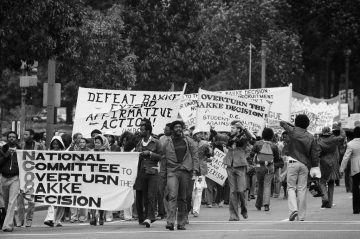Melvin Urofsky in The New York Times:
 For two and a half centuries America enslaved its black population, whose labor was a critical source of the country’s capitalist modernization and prosperity. Upon the abolition of legal, interpersonal slavery, the exploitation and degradation of blacks continued in the neoslavery system of Jim Crow, a domestic terrorist regime fully sanctioned by the state and courts of the nation, and including Nazi-like instruments of ritualized human slaughter. Black harms and losses accrued to all whites, both to those directly exploiting them, and indirectly to all enjoying the enhanced prosperity their social exclusion and depressed earnings made possible. When white affirmative action was first developed on a large scale in the New Deal welfare and social programs, and later in the huge state subsidization of suburban housing — a major source of present white wealth — blacks, as the Columbia political scientist Ira Katznelson has shown, were systematically excluded, to the benefit of the millions of whites whose entitlements would have been less, or whose housing slots would have been given to blacks in any fairly administered system. In this unrelenting history of deprivation, not even the comforting cultural productions of black artists were spared: From Thomas “Daddy” Rice in the early 19th century right down to Elvis Presley, everything of value and beauty that blacks created was promptly appropriated, repackaged and sold to white audiences for the exclusive economic benefit and prestige of white performers, who often added to the injury of cultural confiscation the insult of blackface mockery.
For two and a half centuries America enslaved its black population, whose labor was a critical source of the country’s capitalist modernization and prosperity. Upon the abolition of legal, interpersonal slavery, the exploitation and degradation of blacks continued in the neoslavery system of Jim Crow, a domestic terrorist regime fully sanctioned by the state and courts of the nation, and including Nazi-like instruments of ritualized human slaughter. Black harms and losses accrued to all whites, both to those directly exploiting them, and indirectly to all enjoying the enhanced prosperity their social exclusion and depressed earnings made possible. When white affirmative action was first developed on a large scale in the New Deal welfare and social programs, and later in the huge state subsidization of suburban housing — a major source of present white wealth — blacks, as the Columbia political scientist Ira Katznelson has shown, were systematically excluded, to the benefit of the millions of whites whose entitlements would have been less, or whose housing slots would have been given to blacks in any fairly administered system. In this unrelenting history of deprivation, not even the comforting cultural productions of black artists were spared: From Thomas “Daddy” Rice in the early 19th century right down to Elvis Presley, everything of value and beauty that blacks created was promptly appropriated, repackaged and sold to white audiences for the exclusive economic benefit and prestige of white performers, who often added to the injury of cultural confiscation the insult of blackface mockery.
It is this inherited pattern of racial injustice, and its persisting inequities, that the American state and corporate system began to tackle, in a sustained manner, in the middle of the last century. The ambitious aim of Melvin I. Urofsky’s “The Affirmative Action Puzzle: A Living History From Reconstruction to Today” is a comprehensive account of the nonwhite version of affirmative action. This is a complex and challenging historical task, given that “no other issue divides Americans more.” But Urofsky, by and large, has executed it well. Following the United States Commission on Civil Rights, he defines affirmative action as a program that provides remedy for the historical and continuing discrimination suffered by certain groups; that seeks to bring about equal opportunity; and that specifies which groups are to be protected. Urofsky explores nearly all aspects of the program — its legal, educational, economic, electoral and gender dimensions, from its untitled beginnings during Reconstruction to the present.
More here. (Note: Throughout February, at least one post will honor The Black History Month. This year’s theme is “African Americans and the Vote.” Readers are encouraged to send in their suggestions)
